Attention
TYPO3 v9 has reached its end-of-life September 30th, 2021 and is not maintained by the community anymore. Looking for a stable version? Use the version switch on the top left.
You can order Extended Long Term Support (ELTS) here: TYPO3 ELTS.
$GLOBALS['TYPO3_CONF_VARS']¶
However the main configuration is achieved via a set of global settings
stored in a global array called $GLOBALS['TYPO3_CONF_VARS'].
This chapter describes this global configuration in more details and hints at other configuration possibilities.
File LocalConfiguration.php¶
The global configuration is stored in file typo3conf/LocalConfiguration.php.
This file overrides default settings from typo3/sysext/core/Configuration/DefaultConfiguration.php.
Important
Since configuration settings can be manipulated from within the
TYPO3 CMS backend, the typo3conf/LocalConfiguration.php
must be writable by the web server user.
The local configuration file is basically a long array which is simply returned
when the file is included. It represents the global TYPO3 CMS configuration.
This configuration can be modified/extended/overridden by extensions,
by setting configuration options inside an extension's
ext_localconf.php file. See extension files and locations
for more details about extension structure.
A typical content of typo3conf/LocalConfiguration.php looks like this:
<?php
return [
'BE' => [
'debug' => true,
'explicitADmode' => 'explicitAllow',
'installToolPassword' => '$P$Cbp90UttdtIKELNrDGjy4tDxh3uu9D/',
'loginSecurityLevel' => 'normal',
],
'DB' => [
'Connections' => [
'Default' => [
'charset' => 'utf8',
'dbname' => 'empty_typo3',
'driver' => 'mysqli',
'host' => '127.0.0.1',
'password' => 'foo',
'port' => 3306,
'user' => 'bar',
],
],
],
'EXTCONF' => [
'lang' => [
'availableLanguages' => [
'de',
'eo',
],
],
],
'EXTENSIONS' => [
'backend' => [
'backendFavicon' => '',
'backendLogo' => '',
'loginBackgroundImage' => '',
'loginFootnote' => '',
'loginHighlightColor' => '',
'loginLogo' => '',
],
'extensionmanager' => [
'automaticInstallation' => '1',
'offlineMode' => '0',
],
'scheduler' => [
'maxLifetime' => '1440',
'showSampleTasks' => '1',
],
],
'FE' => [
'debug' => true,
'loginSecurityLevel' => 'normal',
],
'GFX' => [
'jpg_quality' => '80',
],
'MAIL' => [
'transport_sendmail_command' => '/usr/sbin/sendmail -t -i ',
],
'SYS' => [
'devIPmask' => '*',
'displayErrors' => 1,
'encryptionKey' => '0396e1b6b53bf48b0bfed9e97a62744158452dfb9b9909fe32d4b7a709816c9b4e94dcd69c011f989d322cb22309f2f2',
'exceptionalErrors' => 28674,
'sitename' => 'New TYPO3 site',
'systemLogLevel' => 0,
],
];
As you can see, the array is structured on two main levels. The first level corresponds roughly to a category, the second one being properties, which may themselves be arrays.
The configuration categories are:
- BE
Options related to the TYPO3 CMS backend
- DB
Database connection configuration
- EXTCONF
Backend related language pack configuration resides here.
- EXTENSIONS
Extension specific settings
- FE
Frontend-related options.
- GFX
Options related to image manipulation.
Options related to the sending of emails (transport, server, etc.).
- SYS
General options which may affect both the frontend and the backend.
Details on the various configuration options can be found in the Install Tool
as well as the TYPO3 source at
typo3/sysext/core/Configuration/DefaultConfigurationDescription.yaml.
The documentation shown in the Install Tool is automatically extracted from
those values of DefaultConfigurationDescription.yaml.
The Install Tool provides various dedicated modules that change parts of
LocalConfiguration.php, those can be found in ADMIN TOOLS > Settings,
most importantly section Configure installation-wide options:

File AdditionalConfiguration.php¶
Although you can manually edit the typo3conf/LocalConfiguration.php
file, it is limited in scope because the file is expected to return
a PHP array. Also the file is rewritten every time an option is
changed in the Install Tool or some other operation (like changing
an extension configuration in the Extension Manager). Thus custom
code cannot reside in that file.
Such code should be placed in the typo3conf/AdditionalConfiguration.php
file. This file is never touched by TYPO3, so any code will be
left alone.
Furthermore this file is loaded after typo3conf/LocalConfiguration.php,
which means it represents an opportunity to change global configuration
values programmatically if needed.
typo3conf/AdditionalConfiguration.php is a plain PHP file.
There are no specific rules about what it may contain. However since
the code it contains is included on every request to TYPO3 CMS
- whether frontend or backend - you should avoid inserting code
which requires heavy duty processing.
File DefaultConfiguration.php¶
TYPO3 CMS comes with some default settings, which are defined in
file typo3/sysext/core/Configuration/DefaultConfiguration.php.
This is the base configuration, the other files like LocalConfiguration.php
just overlay it.
Here is an extract of that file:
return [
'GFX' => [
'thumbnails' => true,
'thumbnails_png' => true,
'gif_compress' => true,
'imagefile_ext' => 'gif,jpg,jpeg,tif,tiff,bmp,pcx,tga,png,pdf,ai,svg',
// ...
],
// ...
];
You will probably find it interesting to take a look at that file, which also contains values not displayed in the Install Tool and thus not easily available for modification.
